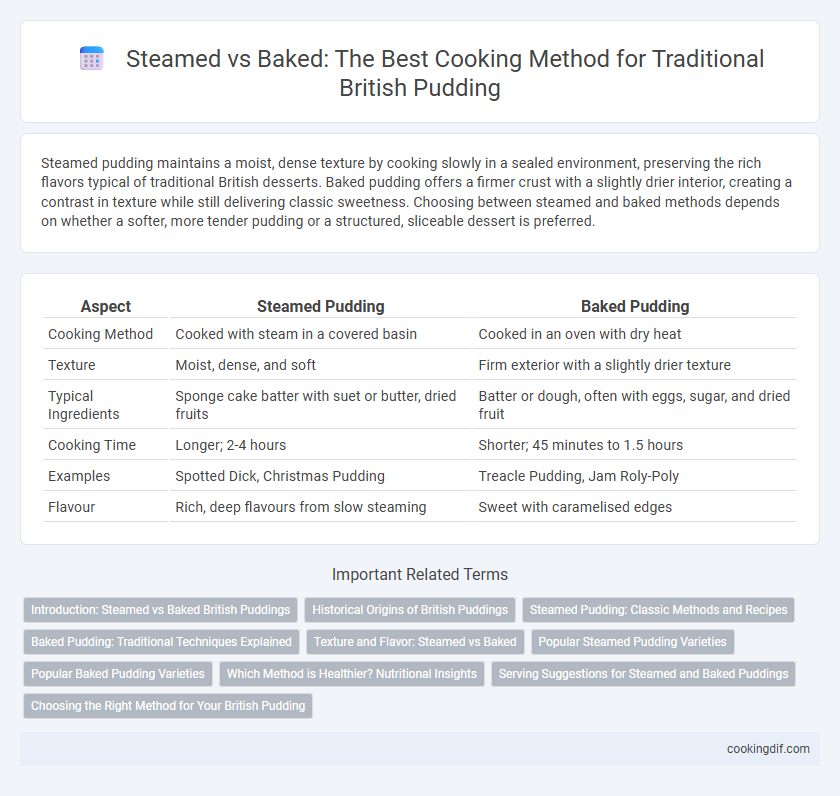Steamed pudding maintains a moist, dense texture by cooking slowly in a sealed environment, preserving the rich flavors typical of traditional British desserts. Baked pudding offers a firmer crust with a slightly drier interior, creating a contrast in texture while still delivering classic sweetness. Choosing between steamed and baked methods depends on whether a softer, more tender pudding or a structured, sliceable dessert is preferred.
Table of Comparison
| Aspect | Steamed Pudding | Baked Pudding |
|---|---|---|
| Cooking Method | Cooked with steam in a covered basin | Cooked in an oven with dry heat |
| Texture | Moist, dense, and soft | Firm exterior with a slightly drier texture |
| Typical Ingredients | Sponge cake batter with suet or butter, dried fruits | Batter or dough, often with eggs, sugar, and dried fruit |
| Cooking Time | Longer; 2-4 hours | Shorter; 45 minutes to 1.5 hours |
| Examples | Spotted Dick, Christmas Pudding | Treacle Pudding, Jam Roly-Poly |
| Flavour | Rich, deep flavours from slow steaming | Sweet with caramelised edges |
Introduction: Steamed vs Baked British Puddings
Traditional British puddings are distinguished by their cooking methods, with steamed puddings offering a moist, dense texture and baked puddings providing a firmer, golden crust. Steaming preserves moisture by cooking the pudding within a sealed environment, ideal for classic favorites like spotted dick and treacle pudding. Baked puddings, such as suet-based fruit breads, develop a richer flavor profile and crispy exterior through dry heat application.
Historical Origins of British Puddings
Traditional British puddings trace their origins to medieval times when steaming was the primary cooking method, preserving moisture and creating dense textures essential for early suet puddings. Baked puddings emerged later, allowing for lighter, sponge-like consistencies as ovens became common in British kitchens during the 18th century. This shift from steaming to baking reflects evolving technology and changing tastes, with steamed puddings maintaining a strong cultural significance through iconic dishes like Christmas pudding.
Steamed Pudding: Classic Methods and Recipes
Steamed pudding remains a cornerstone of traditional British desserts, prized for its moist texture and rich flavor profile. Classic recipes such as spotted dick and treacle pudding rely on extended steaming times, often exceeding two hours, to achieve their distinctive dense and moist consistency. Using suet and breadcrumbs in the mixture enhances the pudding's ability to absorb steam, resulting in a soft yet structured finish prized in authentic British culinary heritage.
Baked Pudding: Traditional Techniques Explained
Baked pudding, a hallmark of traditional British dessert-making, relies on slow, even heat to achieve a dense yet moist texture that contrasts with the lighter, airier steamed versions. Key techniques include using a heavy oven-proof basin, lining it with parchment or greaseproof paper to prevent sticking, and baking in a water bath to maintain consistent moisture levels. This method enhances caramelization and develops rich, deep flavors unique to classic favorites like treacle pudding or spotted dick.
Texture and Flavor: Steamed vs Baked
Steamed traditional British pudding offers a moist, dense texture with a rich, fruity flavor that intensifies during the slow cooking process. Baked pudding tends to have a firmer, slightly drier crumb with caramelized edges, providing a deeper, toasty flavor profile. Both methods enhance the pudding's taste but deliver distinctly different mouthfeel and aromatic experiences.
Popular Steamed Pudding Varieties
Popular steamed British puddings include treacle pudding, spotted dick, and jam roly-poly, each characterized by their moist texture achieved through slow steaming. These varieties retain a rich, dense consistency that distinguishes them from baked puddings, which have a firmer crumb and drier surface. Steamed puddings often incorporate suet or breadcrumbs to enhance their traditional, hearty flavors and maintain moisture during cooking.
Popular Baked Pudding Varieties
Popular baked pudding varieties in traditional British cuisine include sticky toffee pudding, treacle sponge, and spotted dick, each showcasing a rich, moist texture achieved through oven baking. Baking enhances caramelization and creates a slightly firmer crust compared to steamed puddings, which are softer and more moist due to the steaming process. These baked puddings often feature dark sugars, dried fruits, and spices that intensify in flavor under dry heat, making them a favored choice for hearty desserts.
Which Method is Healthier? Nutritional Insights
Steamed traditional British pudding typically retains more moisture and can have a lower fat content due to less evaporation and no need for added fats compared to baked versions. Nutritional analysis reveals steamed puddings often have fewer calories and saturated fats, making them a healthier choice for those monitoring intake. However, ingredient quality and portion size remain crucial factors influencing the overall health benefits of either cooking method.
Serving Suggestions for Steamed and Baked Puddings
Steamed traditional British puddings, such as Christmas pudding, are best served warm with rich custard or brandy butter, enhancing their moist texture and deep flavors. Baked puddings like treacle pudding pair well with cream or a drizzle of golden syrup, offering a firmer texture and caramelized notes. Both styles complement a hot beverage like tea, balancing sweetness and warmth for an authentic British dessert experience.
Choosing the Right Method for Your British Pudding
Steamed British pudding offers a moist and tender texture, ideal for recipes like Christmas pudding or treacle pudding, where slow cooking preserves rich flavors and prevents drying. Baked puddings develop a firmer crust and more caramelized taste, suitable for suet puddings or fruit-filled varieties that benefit from a golden top. Choosing between steaming and baking depends on the pudding type and desired texture, with steaming favored for dense, moist puddings and baking preferred for lighter, crusted desserts.
Steamed vs baked for traditional British pudding Infographic

 cookingdif.com
cookingdif.com